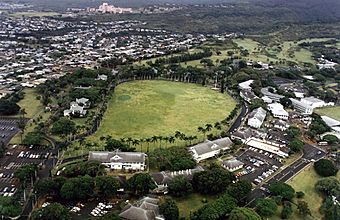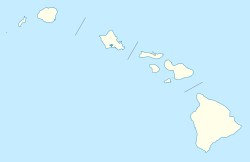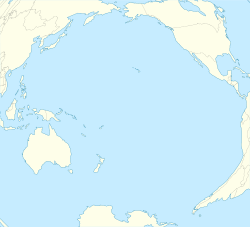Palm Circle facts for kids
|
Palm Circle Historic District
|
|
 |
|
| Location | Roughly bounded by Carter Dr., Richardson and Funston Rds., A and B Sts., Honolulu, Hawaii |
|---|---|
| Area | 32 acres (13 ha) |
| Built | 1907 |
| Architect | Quartermaster Corps |
| NRHP reference No. | 84000104 |
Quick facts for kids Significant dates |
|
| Added to NRHP | October 26, 1984 |
| Designated NHLD | May 28, 1987 |
Palm Circle, also known as the Pineapple Pentagon, is a special historic area within Fort Shafter in Honolulu, Hawaii. It was named a National Historic Landmark in 1987. This means it's a very important place in American history. During World War II, Palm Circle was the main office for the top general and his team. They managed all the U.S. Army forces in the Pacific Ocean.
By 1944, this group was in charge of getting supplies and helping all U.S. Army soldiers in the Central and South Pacific. From 1943 to 1945, they planned how to move troops and supplies for big invasions. These included battles in places like the Gilberts, Marshalls, Marianas, Guam, Palau, and Okinawa.
What is Palm Circle?
Palm Circle is a key part of Fort Shafter. You can find it north of downtown Honolulu, near Interstate H-201. It looks like a big, grassy oval area. Tall royal palm trees surround it, along with Palm Circle Drive.
Around Palm Circle Drive, there are many buildings used by the military. To the north and west, you'll see homes for officers. To the south, there are buildings that used to be barracks for soldiers. Now, these are used for offices.
The Pineapple Pentagon Buildings
On the east side of Palm Circle, there are three office buildings. People often call them the Pineapple Pentagon. These buildings were at the very heart of the United States Army's work in the Pacific War. Richardson Hall (Building T-100) is the only one you can easily see from the circle. This is because the ground there is quite steep.
History of Palm Circle
Fort Shafter was first built in 1905. This was not long after Hawaii became part of the United States. Most of the homes for officers and barracks were built in the years right after that.
After the Japanese Attack on Pearl Harbor in 1941, the Army needed to grow much bigger. So, Richardson Hall and the other office buildings were built in 1943-44. They were made to handle the huge increase in military activity. These buildings have several floors underground, like bunkers. There are also strong tunnels connecting them for safety. General Robert C. Richardson Jr. led the Army's Pacific operations from these buildings. He worked there from 1943 until the war ended.



